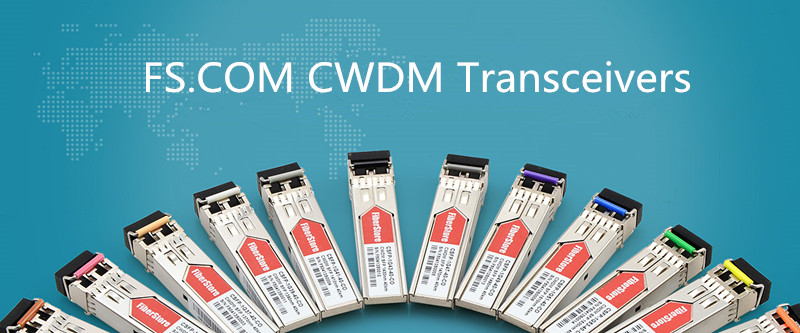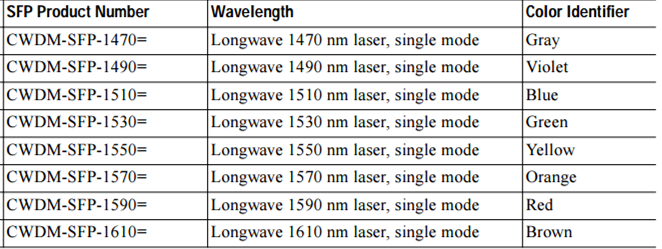Coarse Wavelength Division Multiplexing (CWDM) is one of WDM technologies. It uses up to 20 different wavelengths for data transmission over a single fibre. CWDM applies coarse wavelength grid and it allows low-cost, uncooled lasers, which makes CWDM systems less expensive and consuming less power. There are many optical equipment applying CWDM technology. This article will introduce CWDM transceiver.

CWDM transceiver is a kind of optical modules employing CWDM technology. CWDM transceiver enables connectivity between existing network equipment and CWDM Multiplexers/DeMultiplexers (Mux/DeMux). When used with CWDM Mux/DeMux, CWDM transceiver can increase network capacity by transmitting multiple data channels with separate optical wavelengths (1270 nm to 1610 nm) over the same single fibre. CWDM transceivers are also useful for reducing network equipment inventories by eliminating the need to maintain surplus units/ devices of various fibre types for network repairs or upgrades. CWDM transceiver includes four types, such as CWDM SFP, CWDM SFP+, CWDM XFP and CWDM X2. The following shows more details about these CWDM transceiver modules.
CWDM SFPs are hot-pluggable transceiver modules. CWDM SFP transceivers are SFP MSA (Multi Sourcing Agreement) and IEEE 802.3 & ROHS compliant. CWDM SFPs can provide data rates including 1G, 2G and 4G over the link distance of up to 200 km by connecting with duplex LC single-mode patch cords. CWDM SFPs transmit multiple data channels by combining separate optical wavelengths onto a single fibre to increase network capacity. CWDM SFPs can be used to support the CWDM passive optical system combing CWDM OADM (optical add/drop multiplexer). When CWDM SFPs used with transponders and media converters, these two optical components offer convenient method to convert existing legacy equipment with standard wavelengths or copper ports to CWDM wavelengths.
CWDM SFP+ offers service providers and enterprise companies an easy way to get a scalable 10 Gigabit Ethernet network. It is a cost-effective solution for 10 Gigabit Ethernet applications in campus, data centre and metropolitan area access networks. CWDM SFP+ can transport up to eight channels of 10 Gigabit Ethernet over single-mode fibre strands at the wavelengths including 1610 nm, 1590 nm, 1570 nm, 1550 nm, 1530 nm, 1510 nm, 1490 nm, and 1470 nm. CWDM SFP+ solution is helpful to increase the bandwidth of an existing 10 Gigabit Ethernet optical infrastructure without adding new fibre strands. The solution can be used in parallel with other SFP+ devices on the same platform.
CWDM XFP is a hot-pluggable module designed in Z-direction and mainly used for typical routers and switch line card applications. CWDM XFP transceivers are designed for Storage, IP network and LAN. They comply with CWDM XFP MSA. CWDM XFPs cover the wavelengths from 1270 nm to 1610 nm. These modules can support the distance up to 100 km, which depends on the wavelengths, fibre types and the CWDM Mux/DeMux insertion loss.
CWDM X2 transceiver is designed for CWDM optical data communications such as 10G Ethernet and 10G Fibre Channel applications. CWDM X2 wavelengths are available from 1270 nm to 1610 nm. CWDM X2 is MSA Compliant. It supports the transmission distance up to 80 km connecting with duplex SC single-mode fibrecable.
CWDM technology provides a low-cost solution which allows scalable and easy-to-deploy Gigabit Ethernet and Fibre Channel services. CWDM transceiver enables a more flexible and highly available multi-service network with the combinations of CWDM OADMs and CWDM Mux/DeMux. FS.COM offers all kinds of CWDM transceiver like CWDM SFP, CWDM SFP+, CWDM XFP, CWDM X2. Our CWDM transceivers are compatible with most famous brands and all these optics have been fully tested to make sure high compatibility. For more details about FS.COM CWDM transceiver and other CWDM equipment, please visit our site www.fs.com or contact us via sales@fs.com.


